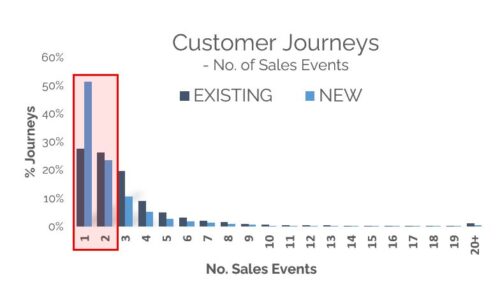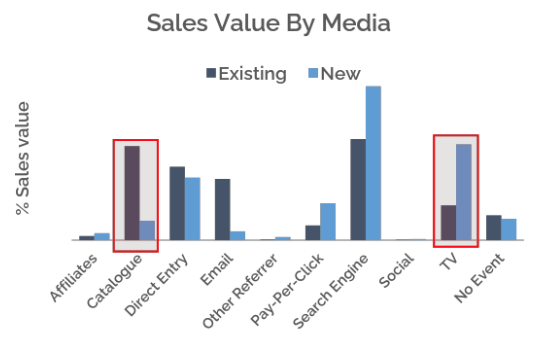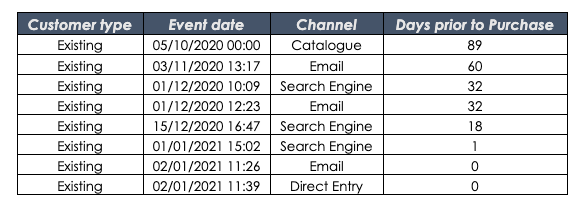It may not come as a complete surprise to be told that your existing customers behave differently from prospects – i.e. people who have never purchased from you before. In fact, the differences are very pronounced, especially when you look at customer journey patterns.
At UniFida we provide technology to help clients capture these customer journeys and then we use AI to analyse them. This enables the true value of different marketing investments to be understood and highlights the journey interactions that are most likely to be successful.
In our study of actual customer journeys, some of the findings are surprising. Possibly the biggest is that existing customers take longer journeys to the point of purchase than prospects. In fact, we found that not only are the journeys longer when measured in days from initial activity to final sale, but so too are the number of sales steps (events) in the journey.
Customer Journeys – New vs. Existing Example

You can see from our analysis that existing customers take on average 29 days, whereas new customers take three days.
As the chart below shows, many prospects buy within just one or two sales events.

Another key finding is that different channels work better for prospects than for existing customers. Search engines and TV can, for instance, be key for prospects, whereas direct channels like email and catalogues work better for customers.

To some extent this is because catalogue and email are “channels of choice” for customer marketing, and hence drive more sales, but also pay per click (PPC) is used more often by prospects.
Different strategies
Given these facts, it’s clear that very different contact strategies are needed for the two different groups. As existing customers seem to prefer the long haul, the challenge is to keep them sufficiently interested during their journeys. This is where emails and texts come in, particularly when the customer has visited your website and not purchased, and also when you want to discourage them from using PPC by offering click-throughs from an email.
By contrast, prospects are more likely to swoop down on a purchase. They may have started their journey as unrecognised browsers, but when they come back to your website conversion techniques, such as website personalisation, become more important. When prospects are on your website there is no time to be wasted.
Example customer journeys
Below are some customer journey examples that illustrate these points. The top two journeys are for existing customers and show the interplay between different channels after a catalogue has been sent to them. We have chosen two particularly long journeys to allow more steps to take place before the purchase.
In the first journey, social media helped close the sale, whilst in the second it was email. Both existing customers used search even though they must have known the name of the company they were looking for, although they may have been looking for alternative suppliers at the same time.
Example: Existing Customer Journey 1

Example: Existing Customer Journey 2

The next two journeys for prospects (new customers) are much shorter. The top one started with the prospect searching and the sale being closed with an email, so he/she must have provided their email address on the website when visiting. In the second case there were two click-throughs from social media followed by a direct entry a day later.
Example: New Customer Journey 1

Example: New Customer Journey 2

What these charts reveal is just some of the complexity, often ignored, surrounding customer journeys and the importance of recording them so that they can be analysed.
By understanding which pathways lead to sales and which don’t, marketers have a far greater chance of making the right moves to convert prospects, and customers, to purchasing.
UniFida is the trading name of Marketing Planning Services Ltd, a London based technology and data science company set up in 2014. Our overall aim is to help organisations build more customer value at less marketing cost.
Our technology focus has been to develop UniFida. Data science business comes both from existing users of UniFida, and from clients looking to us to solve their more complex data related marketing questions.
Marketing is changing at an explosive speed. Our ambition is to help our clients stay empowered and ahead in this challenging environment.


